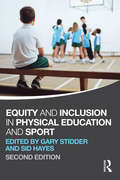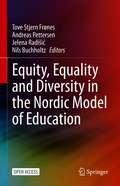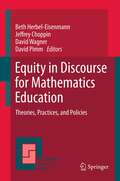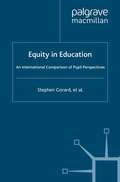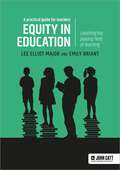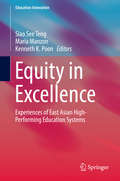- Table View
- List View
Equitable Education for Marginalized Youth in Latin America and the Caribbean (Routledge Research on Educational Equity in Developing Nations)
by Stacey N. J. BlackmanThis edited volume examines the thrust towards equity in education for marginalized and out-of-school youth, as well as youth with disabilities, in countries located in the Global South. Using a critical cross-cultural lens to interrogate the historical, empirical, and theoretical discourses associated with achieving UNESCO’s equity in education agenda, the book showcases the work of scholars from developed and developing nations in examining inclusive education. Drawing attention to the nature, impact, and effects of marginalization, the book ultimately demonstrates the ability of education systems in the Global South to be innovative and agile despite current resource challenges. This text will benefit scholars, academics, and students in the fields of international and comparative education, education policy, and inclusion and special educational needs education more broadly. Those involved with Caribbean and Latin American studies, the sociology of education, and diaspora studies in general will also benefit from this volume.
Equity and Access to High Skills through Higher Vocational Education (Palgrave Studies in Adult Education and Lifelong Learning)
by Elizabeth Knight Ann-Marie Bathmaker Gavin Moodie Kevin Orr Susan Webb Leesa WheelahanThis book explores new and distinctive forms of higher vocational education across the globe, and asks how the sector is changing in response to the demands of the 21st century. These new forms of education respond to two key policy concerns: an emphasis on high skills as a means to achieve economic competitiveness, and the promise of open access for adults hitherto excluded from higher education. Examining a range of geographic contexts, the editors and contributors aim to address these contexts and highlight various similarities and differences in developments. They locate their analyses within the various political and socio-economic contexts, which can make particular reforms possible and achievable in one context and almost unthinkable in another. Ultimately, the book promotes a critical understanding of evolving provisions of higher vocational education, refusing assumptions that policy borrowing from apparently ‘successful’ countries offers a straightforward model for others to adopt.
Equity and Excellence in Educational Testing and Assessment (Evaluation in Education and Human Services #40)
by Arie L. Nettles Michael T. Nettles5 TABLE I Average Reading Proficiency and Achievement Levels by RacelEthnicity Grades 4 8 and 12 1992 Reading Assessment Percentage of Student At or Above Percentage of Average Proficient Basic Below Basic Advanced I Students Proficiency I Grade 4 White 71 226 6 31 68 J2 69 16 193 0 Black 7 31 Hispanic 9 202 2 13 41 59 Asian/Pacific Islander 2 216 2 21 55 45 American Indian 2 208 2 15 50 50 Grade 8 70 White 268 3 34 77 23 Black 16 238 0 8 44 56 Hispanic 10 242 I 13 49 51 AsianlPacific Islander 3 270 6 38 77 23 American Indian 1 251 I 18 60 40 Grade 12 White 72 297 4 43 82 18 Black 15 272 0 16 54 46 9 277 Hispanic 1 21 61 39 Asian/Pacific Islander 4 291 4 39 74 26 American Indian 0 272 I 24 S2 48 Source: National Assessment of Educational Progress (NAEP), 1992 Reading Assessment. Reprinted from "NAEP 1992 Reading Report Card for the Nation and the States. " l be reading at the advanced level . A much higher percent of White Americans are performing at the proficient and advanced levels.
Equity and Formative Assessment in Higher Education: Advancing Culturally Responsive Assessment
by Dorit Alt Nirit RaichelThis book discusses instruction, learning, and assessment in higher education with an emphasis on several effective formative assessment tools and methods such as digital badges, reflective journals, and peer assessment used in learning environments comprising students of diverse, multicultural backgrounds. Each chapter provides a rich theoretical review, followed by a case study detailing the challenges involved in using those assessment methods in a diverse classroom, as well as practical suggestions for removing potential barriers, especially for minority students. Most of the narrated case studies are accompanied by episodes, thoughts, and feelings expressed by both students and instructors throughout the assessment processes. This book provides a valuable updated reference source for pedagogical and research purposes for a wide audience. Students, teachers, policymakers, curriculum designers, and teacher educators interested in fostering initiatives in higher education can undoubtably benefit from this book's contents, which are aimed at adapting teaching–learning assessment processes to the unique learning needs of culturally diverse student populations.
Equity and Inclusion in Physical Education and Sport
by Gary Stidder Sid HayesAn essential component of good practice in physical education is ensuring inclusivity for all pupils, regardless of need, ability or background. Now in a fully revised and updated new edition, Equity and Inclusion in Physical Education fully explores the theoretical and practical issues faced by physical education teachers today. The book amalgamates areas of critical debate within the world of physical education and is structured around the key topics of ability, special educational needs, gender, sexuality, social class, race and ethnicity. These issues are discussed in relation to principles of equity, equality of opportunity, pedagogy, differentiation, curriculum planning and cultural awareness. Other chapters explore contemporary themes such as healthism and obesity and values in physical education and policy, whilst a chapter new to this edition demonstrates the importance of reflexivity and critical self-reflection in good inclusive practice. As well as being a perfect introductory text for any course on inclusion or inclusive practice in physical education, the book offers invaluable, practical advice for established professionals, newly qualified teachers and trainees about how to meet equity and inclusion requirements. Examples of good practice are included throughout, as well as guidance on how to implement an inclusive PE curriculum within the school.
Equity and Inclusion in Physical Education and Sport
by Gary Stidder Sid HayesAn essential component of good practice in physical education is ensuring inclusivity for all pupils, regardless of need, ability or background. Now in a fully revised and updated new edition, Equity and Inclusion in Physical Education fully explores the theoretical and practical issues faced by physical education teachers today. The book amalgamates areas of critical debate within the world of physical education and is structured around the key topics of ability, special educational needs, gender, sexuality, social class, race and ethnicity. These issues are discussed in relation to principles of equity, equality of opportunity, pedagogy, differentiation, curriculum planning and cultural awareness. Other chapters explore contemporary themes such as healthism and obesity and values in physical education and policy, whilst a chapter new to this edition demonstrates the importance of reflexivity and critical self-reflection in good inclusive practice. As well as being a perfect introductory text for any course on inclusion or inclusive practice in physical education, the book offers invaluable, practical advice for established professionals, newly qualified teachers and trainees about how to meet equity and inclusion requirements. Examples of good practice are included throughout, as well as guidance on how to implement an inclusive PE curriculum within the school.
Equity and Quality Dimensions in Educational Effectiveness (Policy Implications of Research in Education #8)
by Leonidas Kyriakides Bert Creemers Evi CharalambousThis book aims to make a contribution to the theory, research and practice on quality and equity in education by providing a comprehensive overview of these two dimensions of educational effectiveness and proposing a methodological instrument that may be used to measure the contribution that each school can make to promoting equity. The importance of using this instrument is demonstrated by analysing results of various effectiveness studies conducted over the last decade. The book draws upon research across the world, especially research conducted in the Europe, the United States, and Australasia. It is shown that promoting equity has no negative effect on the promotion of quality. The importance of using this methodological instrument to identify factors that promote both quality and equity at different educational levels (i.e. teacher, school and educational system) is stressed. The book also demonstrates how we can measure stability and changes in the effectiveness status of schools over time in terms of fostering quality and equity. In addition it underlines the importance of identifying factors measuring changes in the effectiveness status of schools in terms of equity and points to the alternative strategies that can be used at school and system level. In our attempt to encourage the further development and use of this methodology for school improvement purposes, we demonstrate how experimental studies can be conducted to discover whether and under which conditions the proposed methodology can help schools promote both quality and equity. Finally, implications for school evaluation, research, educational policy and practice are drawn. In this way, the book contributes significantly to the debate on how quality and equity can be achieved and encourages policy-makers and practitioners not to view these two dimensions of effectiveness as being in competition with each other but as constituting the major objectives of any reform policy and/or improvement effort at school and/or national levels.
Equity and Science Education Reform
by Sharon J. LynchThis lucid, accessible, thought-provoking discussion of issues related to equity in science education reform is for science educators, including idealists and exacting pragmatists, who are dedicated to exploring what it means to put into practice rallying cries like "science literacy for all," "equity and excellence," and "standards-based reform." Intended as an enjoyable and stimulating read, as opposed to a comprehensive summary of everything ever written about equity in science education, it is a response to the new science education standards and reforms, with their goal of science literacy for all. If this goal is to be taken seriously, the implications are immense. A central purpose of this book is to project and discuss how achieving this goal would affect science education reform and vice versa. The work is research based, using statistics, tables, and figures drawn primarily from NSF reports and other public information documents to provide a foundation for equity concerns. However, these statistics are not the main focus of the book. Rather, they are used to make a case, backed by pertinent research, the literature on best practice, and provocative examples from schools and classrooms. Charts, tables, and graphic organizers provide visual evidence and enhance the arguments presented. Moving from research-based studies to classroom stories, Equity and Science Education Reform encourages readers to think about the complexity of the issues. No easy answers or quick fixes are offered. Researching across "identity" areas and attempting to unite them in a discussion that recognizes both the common elements as well as important distinctions, it provides a comprehensive picture of equity concerns across ethnicity, class, gender, and location. Encompassing a broad literature in science education, reform and policy, and equity issues, it offers an "equity schema" as a unifying concept to guide discussion throughout. This book is based, in part, on a series of nine background papers that were commissioned by the American Association for the Advancement of Science's Project 2061 and the summary document, which was written by the author of this book. But it goes far beyond the original study to provide a consistent, coherent, and lively discussion that vividly illustrates the issues raised by the experiences of teachers and students who are struggling with equity principles in the context of science education reform.
Equity and Science Education Reform
by Sharon J. LynchThis lucid, accessible, thought-provoking discussion of issues related to equity in science education reform is for science educators, including idealists and exacting pragmatists, who are dedicated to exploring what it means to put into practice rallying cries like "science literacy for all," "equity and excellence," and "standards-based reform." Intended as an enjoyable and stimulating read, as opposed to a comprehensive summary of everything ever written about equity in science education, it is a response to the new science education standards and reforms, with their goal of science literacy for all. If this goal is to be taken seriously, the implications are immense. A central purpose of this book is to project and discuss how achieving this goal would affect science education reform and vice versa. The work is research based, using statistics, tables, and figures drawn primarily from NSF reports and other public information documents to provide a foundation for equity concerns. However, these statistics are not the main focus of the book. Rather, they are used to make a case, backed by pertinent research, the literature on best practice, and provocative examples from schools and classrooms. Charts, tables, and graphic organizers provide visual evidence and enhance the arguments presented. Moving from research-based studies to classroom stories, Equity and Science Education Reform encourages readers to think about the complexity of the issues. No easy answers or quick fixes are offered. Researching across "identity" areas and attempting to unite them in a discussion that recognizes both the common elements as well as important distinctions, it provides a comprehensive picture of equity concerns across ethnicity, class, gender, and location. Encompassing a broad literature in science education, reform and policy, and equity issues, it offers an "equity schema" as a unifying concept to guide discussion throughout. This book is based, in part, on a series of nine background papers that were commissioned by the American Association for the Advancement of Science's Project 2061 and the summary document, which was written by the author of this book. But it goes far beyond the original study to provide a consistent, coherent, and lively discussion that vividly illustrates the issues raised by the experiences of teachers and students who are struggling with equity principles in the context of science education reform.
Equity Audits and School Resource Allocation: Applying Critical Resource Theory to Increase Equal Opportunity in Schools
by Leslie S. Kaplan William A. OwingsEquity Audits and School Resource Allocation explores how to apply Critical Resource Theory (CReT) to conduct school equity audits, ultimately preparing educational leaders to find equity disparities, engage in more equitable resource allocation in their schools, and improve equal educational opportunity for every student. With case study scenarios woven throughout the book, the authors explore key equity factors, including per-pupil expenditures, poverty, teacher and principal quality, program equity, and achievement equity. They also walk through the process of implementing the 5-step CReT equity audit within a school district or school at any level. Owings and Kaplan also describe the communication and interpersonal factors that equity advocates will need to leverage to gain community support for equity process, considering the data, and rethinking their policies and practices. In today’s education context, the problems of equitably funding public schools and allocating learning resources to generate more equal opportunities and higher outcomes for traditionally underserved children are particularly relevant. This important book is designed for course use in leadership preparation programs, for practicing principals and superintendents, and for educational leadership scholars.
Equity Audits and School Resource Allocation: Applying Critical Resource Theory to Increase Equal Opportunity in Schools
by Leslie S. Kaplan William A. OwingsEquity Audits and School Resource Allocation explores how to apply Critical Resource Theory (CReT) to conduct school equity audits, ultimately preparing educational leaders to find equity disparities, engage in more equitable resource allocation in their schools, and improve equal educational opportunity for every student. With case study scenarios woven throughout the book, the authors explore key equity factors, including per-pupil expenditures, poverty, teacher and principal quality, program equity, and achievement equity. They also walk through the process of implementing the 5-step CReT equity audit within a school district or school at any level. Owings and Kaplan also describe the communication and interpersonal factors that equity advocates will need to leverage to gain community support for equity process, considering the data, and rethinking their policies and practices. In today’s education context, the problems of equitably funding public schools and allocating learning resources to generate more equal opportunities and higher outcomes for traditionally underserved children are particularly relevant. This important book is designed for course use in leadership preparation programs, for practicing principals and superintendents, and for educational leadership scholars.
Equity-Centered Trauma-Informed Education (Equity and Social Justice in Education Series)
by Alex Shevrin VenetEducators must both respond to the impact of trauma, and prevent trauma at school. Trauma-informed initiatives tend to focus on the challenging behaviors of students and ascribe them to circumstances that students are facing outside of school. This approach ignores the reality that inequity itself causes trauma, and that schools often heighten inequities when implementing trauma-informed practices that are not based in educational equity. In this fresh look at trauma-informed practice, Alex Shevrin Venet urges educators to shift equity to the center as they consider policies and professional development. Using a framework of six principles for equity-centered trauma-informed education, Venet offers practical action steps that teachers and school leaders can take from any starting point, using the resources and influence at their disposal to make shifts in practice, pedagogy, and policy. Overthrowing inequitable systems is a process, not an overnight change. But transformation is possible when educators work together, and teachers can do more than they realize from within their own classrooms.
Equity-Centered Trauma-Informed Education (Equity and Social Justice in Education Series)
by Alex Shevrin VenetEducators must both respond to the impact of trauma, and prevent trauma at school. Trauma-informed initiatives tend to focus on the challenging behaviors of students and ascribe them to circumstances that students are facing outside of school. This approach ignores the reality that inequity itself causes trauma, and that schools often heighten inequities when implementing trauma-informed practices that are not based in educational equity. In this fresh look at trauma-informed practice, Alex Shevrin Venet urges educators to shift equity to the center as they consider policies and professional development. Using a framework of six principles for equity-centered trauma-informed education, Venet offers practical action steps that teachers and school leaders can take from any starting point, using the resources and influence at their disposal to make shifts in practice, pedagogy, and policy. Overthrowing inequitable systems is a process, not an overnight change. But transformation is possible when educators work together, and teachers can do more than they realize from within their own classrooms.
Equity, Equality and Diversity in the Nordic Model of Education
by Tove Stjern Frønes Andreas Pettersen Jelena Radišić Nils BuchholtzDoes the Nordic model of education still stand by its original principles and safeguard education for all? This Open Access volume is a carefully crafted collection of chapters that investigate the different aspects of equity, equality and diversity across the education systems in the Nordic countries. Based on data from various national and international large-scale assessments, the volume provides a better understanding of both the functions and foundations of the Nordic model, along with how the concepts mentioned above are enacted in practice. Across the chapters, data from different national and international large-scale assessment studies are used for cross- and single-country analyses on a variety of issues related to equity, equality and inequality in diverse educational settings. The investigations address different subject domains (i.e., mathematics, science, reading), age and grade groups, but also issues related to teachers and the schools themselves. In addition to these empirical chapters, the book addresses the theoretical and methodological underpinnings of the ideas and tools embedded in the phenomena of equity and equality and how they have met in the Nordic model of education.
Equity, Exclusion and Everyday Science Learning: The Experiences of Minoritised Groups (Routledge Research in Education)
by Emily DawsonEquity, Exclusion and Everyday Science Learning explores how some people are excluded from science education and communication. Taking the role of science in society as a starting point, it critically examines the concept of equity in science learning and develops a framework to support inclusive change. This book presents a theoretically informed, empirically detailed analysis of how people from minoritised groups in the UK experience science and everyday science learning resources in their daily lives. The book draws on two years of ethnographic research carried out in London with five community groups who identified as Asian, Somali, Afro-Caribbean, Latin American and Sierra Leonean. Exploring their experiences of everyday science learning from a sociological perspective, with social justice as a guiding concern, this book opens with a theory of exclusion and closes with a theory of inclusion. Equity, Exclusion and Everyday Science Learning is not only an essential text for postgraduate students and postdoctoral researchers of Science Education, Science Communication and Museum Studies, but for any professional working in museums, science centres and institutional public engagement.
Equity, Exclusion and Everyday Science Learning: The Experiences of Minoritised Groups (Routledge Research in Education)
by Emily DawsonEquity, Exclusion and Everyday Science Learning explores how some people are excluded from science education and communication. Taking the role of science in society as a starting point, it critically examines the concept of equity in science learning and develops a framework to support inclusive change. This book presents a theoretically informed, empirically detailed analysis of how people from minoritised groups in the UK experience science and everyday science learning resources in their daily lives. The book draws on two years of ethnographic research carried out in London with five community groups who identified as Asian, Somali, Afro-Caribbean, Latin American and Sierra Leonean. Exploring their experiences of everyday science learning from a sociological perspective, with social justice as a guiding concern, this book opens with a theory of exclusion and closes with a theory of inclusion. Equity, Exclusion and Everyday Science Learning is not only an essential text for postgraduate students and postdoctoral researchers of Science Education, Science Communication and Museum Studies, but for any professional working in museums, science centres and institutional public engagement.
Equity for Women in Science: Dismantling Systemic Barriers to Advancement
by Cassidy R. Sugimoto Vincent LarivièreThe first large-scale empirical analysis of the gender gap in science, showing how the structure of scientific labor and rewards—publications, citations, funding—systematically obstructs women’s career advancement.If current trends continue, women and men will be equally represented in the field of biology in 2069. In physics, math, and engineering, women should not expect to reach parity for more than a century. The gender gap in science and technology is narrowing, but at a decidedly unimpressive pace. And even if parity is achievable, what about equity?Equity for Women in Science, the first large-scale empirical analysis of the global gender gap in science, provides strong evidence that the structures of scientific production and reward impede women’s career advancement. To make their case, Cassidy R. Sugimoto and Vincent Larivière have conducted scientometric analyses using millions of published papers across disciplines. The data show that women are systematically denied the chief currencies of scientific credit: publications and citations. The rising tide of collaboration only exacerbates disparities, with women unlikely to land coveted leadership positions or gain access to global networks. The findings are unequivocal: when published, men are positioned as key contributors and women are relegated to low-visibility technical roles. The intersecting disparities in labor, reward, and resources contribute to cumulative disadvantages for the advancement of women in science.Alongside their eye-opening analyses, Sugimoto and Larivière offer solutions. The data themselves point the way, showing where existing institutions fall short. A fair and equitable research ecosystem is possible, but the scientific community must first disrupt its own pervasive patterns of gatekeeping.
Equity in Discourse for Mathematics Education: Theories, Practices, and Policies (Mathematics Education Library #55)
by Beth Herbel-Eisenmann, Jeffrey Choppin, David Wagner and David PimmThis book explores the connection between the ways people speak in mathematics classrooms and their opportunities to learn mathematics. The words spoken, heard, written and read in mathematics classrooms shape students’ sense of what mathematics is and of what people can do with mathematics. The authors employ multiple perspectives to consider the means for transformative action with respect to increasing opportunities for traditionally marginalized students to form mathematical identities that resonate with their cultural, social, linguistic, and political beings.
Equity in Education: An International Comparison of Pupil Perspectives
by Stephen Gorard Emma SmithBased on the views of teenagers across Europe and in the Far East, this book argues that we need to reconsider how we judge schools and what they are for. It shows that the treatment of pupils in schools makes more difference to teenagers' views on society, and on what it means to be fair, than it does to differences in attainment.
Equity in education: Levelling the playing field of learning - a practical guide for teachers
by Lee Elliot Major Emily Briant'Comprehensive and groundbreaking.' Dylan WiliamEquity in Education sets out a new equity-based approach in education to help teachers improve the prospects of under-resourced and working-class pupils.The equity approach recognises that we must address our own cultural biases and barriers within the classroom, while helping to remove extra barriers to learning experienced by children outside schools. Based on thousands of research studies and years of working with expert teachers, the book sets out the principles and practical strategies for trainee teachers, teachers and teacher leaders.Adopting an equity mindset involves four key principles:· equity not equality - doing more to overcome the extra barriers some learners experience· capacity not deficit thinking - recognising the talents in all pupils· deep not shallow relationships - developing authentic individual relationships with pupils· multiple not singular talents - acknowledging that human talents come in many forms.Equity in Education also advocates the national policies that would enable teachers to prioritise an equitable approach and reduce divides between the education haves and have-nots.
Equity in education: Levelling The Playing Field Of Learning
by Lee Elliot Major Emily Briant'Comprehensive and groundbreaking.' Dylan WiliamEquity in Education sets out a new equity-based approach in education to help teachers improve the prospects of under-resourced and working-class pupils.The equity approach recognises that we must address our own cultural biases and barriers within the classroom, while helping to remove extra barriers to learning experienced by children outside schools. Based on thousands of research studies and years of working with expert teachers, the book sets out the principles and practical strategies for trainee teachers, teachers and teacher leaders.Adopting an equity mindset involves four key principles:· equity not equality - doing more to overcome the extra barriers some learners experience· capacity not deficit thinking - recognising the talents in all pupils· deep not shallow relationships - developing authentic individual relationships with pupils· multiple not singular talents - acknowledging that human talents come in many forms.Equity in Education also advocates the national policies that would enable teachers to prioritise an equitable approach and reduce divides between the education haves and have-nots.
Equity in Excellence: Experiences of East Asian High-Performing Education Systems (Education Innovation Series)
by Siao See Teng Maria Manzon Kenneth K. PoonThis book offers a comprehensive picture of high-performing East Asian education systems, beyond their outstanding achievements in international assessments, such as PISA and TIMSS. Situating “excellence” within discussions of “equity”, it contextualises the conceptions and pursuits of equity amid the development of education systems, policy and curricula in selected East Asian societies. While parallels could be observed across the systems, including high-stakes assessment culture, increasing credentialism and high investment of family educational resources, there are also divergences in approaches and outcomes relating to equity policies and practices. In light of the challenges presented by low fertility rates, ageing populations, migration, and the economic demands of the 21st century, the book addresses these systems’ attempts to cater to further diversified student populations and maintain equity in excellence. As the international community relentlessly seeks to enhance equity in education, there is much these East Asian education systems can share. This book has appeal internationally to researchers, policymakers, educators, and anyone interested in East Asian education and equity.
Equity in Higher Education: Time for Social Justice Praxis (ISSN)
by Penny Jane Burke Matt LumbIn a global context of growing inequality and socio-environmental crises, Equity in Higher Education considers the issues and challenges for progressing an equity agenda.It advances a unique multidimensional framework based on theoretical and conceptual threads, including critical, feminist, decolonial, post-structural, and sociological discourses. It also provides readers with the sophisticated insights and tools urgently needed to challenge long-standing, entrenched, and insidious inequalities at play in and through higher education.Written as a form of a pedagogical interaction, and addressing nuanced temporal and spatial inequalities, this key resource will be of value to policymakers, practitioners, educators, and scholars committed to progressive and groundbreaking approaches that can engage the ongoing challenges of transforming higher education towards more just realities.
Equity in Higher Education: Time for Social Justice Praxis (ISSN)
by Penny Jane Burke Matt LumbIn a global context of growing inequality and socio-environmental crises, Equity in Higher Education considers the issues and challenges for progressing an equity agenda.It advances a unique multidimensional framework based on theoretical and conceptual threads, including critical, feminist, decolonial, post-structural, and sociological discourses. It also provides readers with the sophisticated insights and tools urgently needed to challenge long-standing, entrenched, and insidious inequalities at play in and through higher education.Written as a form of a pedagogical interaction, and addressing nuanced temporal and spatial inequalities, this key resource will be of value to policymakers, practitioners, educators, and scholars committed to progressive and groundbreaking approaches that can engage the ongoing challenges of transforming higher education towards more just realities.
Equity In Mathematics Education: Influences Of Feminism And Culture
by Gabriele KaiserThis text provides a critical overview of current thinking about equity issues in the teaching and learning of mathematics. Grounded in feminist theories of curriculum change and a broad range of cultural perspectives, the new approaches described here go beyond "special programmes" and "experimental treatments" designed to correct perceived problems and deficits. Instead they establish how improved instructional practices and a fuller understanding of the nature of the mathematical enterprise can overcome the systemic obstacles that have thwarted women's participation in this important field.; This book will appeal to all those who are interested in the mathematical education of women, including teachers, parents, administrators and researchers.




